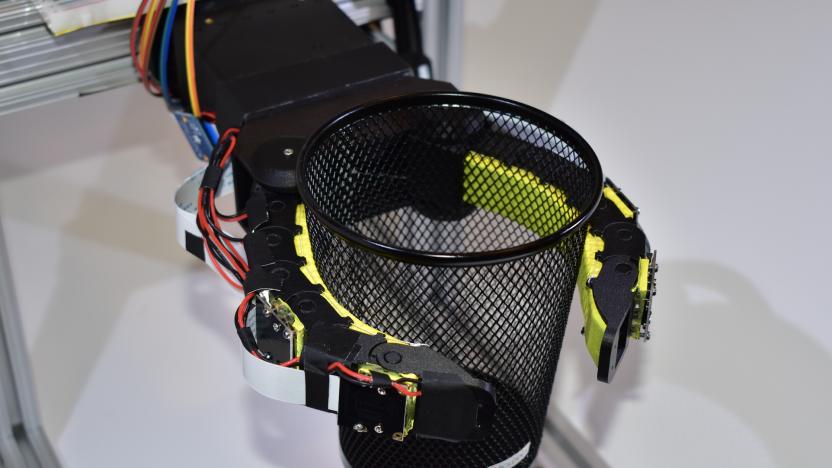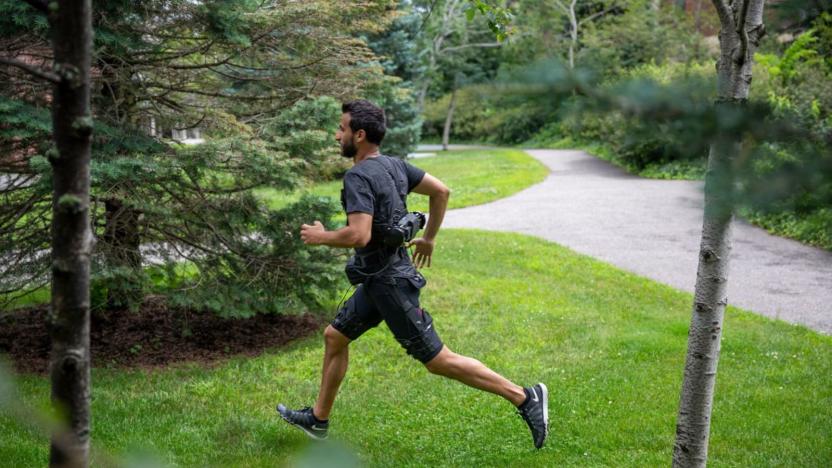researchers
Latest

Facebook will let researchers study its election ad targeting data
'Understanding the online political advertising landscape is key to protecting elections.'

Researchers built robotic skin with a sense of touch
Using Intel's neuromorphic Loihi chip, researchers created a robotic skin that detects touch more than 1,000 times faster than the human sensory nervous system.

MIT gives soft robots a better sense of touch and spatial awareness
Researchers from MIT give robotic grippers a better sense what they’re gripping and how much force to use.

Browser add-on verifies that sites actually honor their privacy policies
Researchers created a browser plug-in that verifies whether a website is compliant with its own privacy policy.

Google spent a record sum rewarding researchers for hacking its products
Google is not messing around when it comes to its bug bounty program. Last year it paid out $6.5 million to researchers that reported vulnerabilities -- almost double the $3.4 million paid out in 2018. The largest single award was for $201,337, which was given to Guang Gong of Alpha Labs, who discovered a major exploit on the Pixel 3.

Google researchers taught an AI to recognize smells
For decades, perfumers and scientists have struggled to predict the relationship between a molecule's structure and its scent. While scientists can look at a wavelength of light and identify what color it is, when it comes to scents, scientists can't simply look at a molecule and identify its odor. Researchers from the Google Brain Team are hoping AI might change that. In a paper published on Arxiv, they explain how they're training AI to recognize smells.

Harvard's noodly robot fingers are great at grabbing jellyfish
Robots can be a bit heavy-handed. Their forceful grip might not be a problem when they're moving boxes in a warehouse, but they can damage fragile marine creatures like jellyfish. Researchers may have a solution. They've created a robotic hand with a squishy grabber and a gentle grip that uses "fettuccini-like silicone fingers" to catch and release fragile, gelatinous jellyfish.

Libra Association opens Bug Bounty program to everyone
Facebook's Calibra digital wallet isn't expected to launch until 2020. But, as you might expect, the organization created to protect the Libra cryptocurrency that will be used with Calibra (and other Libra financial services) is already working to ensure it keeps people's data safe. We're talking about the Libra Association, the independent group in charge of governing Libra, which has announced it is now welcoming all researchers who want to help test the security of its blockchain technology -- in exchange for financial rewards, naturally. The Libra Bug Bounty program was announced at the time when the Libra Association became official in June, but now the nonprofit will be opening it to the public.

This hip-hugging exosuit uses AI to make walking and running easier
Robotic devices have been used to help people walk or run in rehabilitation settings, but until now, they've been tethered and limited to a single action, like walking or running. In a paper published in Science today, a team of researchers explain how they're going to change that. The researchers -- from Harvard University and the University of Nebraska Omaha -- have developed a portable exosuit that uses AI to assist users with both walking and running.

France gives 'Make our Planet Great Again' grants to US scientists
France has backed up statements that it's willing to reward America's climate researchers now that the US has backed out of the Paris global warming accord. President Emmanuel Macron handed out 13 of 18 "Make our Planet Great Again" grants worth millions of euros to US-based scientists. "You will now settle in, develop projects, enrich French, European research, because we've decided to give even bigger resources and to fully recognize what you are doing," Macron said in a speech at Paris startup hub Station F.

Federal report says humans are the cause of climate change
Today, over a dozen federal agencies released the Climate Science Special Report, which is a product of the National Climate Assessment -- a congressionally mandated review that takes place every four years. In it, hundreds of scientists from dozens of government agencies and academic institutions present evidence that supports the existence of a human-caused warming planet and all of the consequences that come with it. "This assessment concludes, based on extensive evidence, that it is extremely likely that human activities, especially emissions of greenhouse gases, are the dominant cause of the observed warming since the mid-20th century," the report stated. "For the warming over the last century, there is no convincing alternative explanation supported by the extent of the observational evidence."

Makers of uncrackable ransomware hand over the key
The creators of a virus that forces users to pay to recover their own files seem to have turned over a new leaf. Security researchers at ESET are reporting that TeslaCrypt's developers posted the master encryption key, enabling ESET to develop a free fix. According to the firm, the creators of the virus were "wrapping up" their activities, and when a researcher asked for the master key, it was simply handed over. ESET has subsequently been able to produce a decryption tool (available here) that'll enable anyone affected to get their files back.

#ICYMI: A cockroach robot, new half-boat drones and more
#fivemin-widget-blogsmith-image-53482{display:none;} .cke_show_borders #fivemin-widget-blogsmith-image-53482, #postcontentcontainer #fivemin-widget-blogsmith-image-53482{width:570px;display:block;} try{document.getElementById("fivemin-widget-blogsmith-image-53482").style.display="none";}catch(e){}Today on In Case You Missed It: The tiny robot that's modeled after cockroaches because science is disgusting; the family-friendly tech gadget to teach your two-year-old to call her grandma, if only you didn't have to install the corresponding app on your Mom's phone; and Parrot's new drones include a hydrofoil option, for the sailors who know how cool that is. (If you don't, check out this physics explainer for how a hydrofoil gives speed and rad points.)

Public medical database aims to 'open-source' your body
Science needs your private data to speed up breakthroughs. Researchers find it increasingly hard to recruit participants. Apple did its part earlier this month with ResearchKit and made an attempt to get users involved in medical studies. But it soon ran into its share of limitations. Now Open Humans Network, a new public database, hopes to make medical research less opaque. The site finds a connection between people who want to share their medical data with researchers in need of that information. It relies on people who, given the choice, will feel encouraged to share their personal data on an open, research platform. Jason Bobe, project director, calls it "open-sourcing your body."

Researchers create a virtual screen with touchable objects
A team from the University of Tokyo is putting their own spin on a touchscreen. By combining an infrared sensor with ultrasound technology, the group of researches have managed to design a virtual display that's as thin as air and can let you feel every object you're touching. Dubbed HaptoMime, the project uses a reflective surface to give you that physically tangible feeling, while a change in ultrasonic pressure make it possible to create a number of different sensations -- say you're playing a digital keyboard (like the one pictured above), the feedback from it isn't the same you get with other type of applications. Check out the HaptoMime holographic screen in action after the break.

Kids with disabilities can teach this robot how to play 'Angry Birds'
As a way to help children dealing with cognitive and motor-skill disabilities, researchers from Georgia Tech have developed a rehabilitation tool that pairs a robot and an Android tablet. To demonstrate this system in action, the research team used Angry Birds to let kids teach the humanoid how to play Rovio's popular game. Essentially, the robot is smart enough to learn by simply watching each move the child makes while flinging those birds toward the iconic green pigs. "The robot is able to learn by watching because it knows how interaction with a tablet app is supposed to work," writes project leader Ayanna Howard, a professor at Georgia Tech. "It recognizes that a person touched here and ended there, then deciphers the information that is important and relevant to its progress."

Scientists encode Shakespeare sonnets, MP3 and more into glitch-free DNA
We've seen scientists experiment with DNA as a storage medium -- most recently with a Harvard team fitting 704TB of data onto a single gram of the genetic material -- and it looks like that research trend is only picking up. Scientists at the European Bioinformatics Institute in the UK have encoded an MP3 file -- along with a digital photo and all 154 of Shakespeare's sonnets -- into DNA, with a hulking storage density of 2.2 petabytes per gram. The information was written using the language of DNA's four bases (A, T, C and G, if you remember high-school bio), and to provide error correction the scientists reserved one of the letters to break up long runs of any of the other three bases. In practice, this system allowed for 100-percent accuracy in sequencing and retrieving the encoded files. Though DNA storage is still quite expensive, the researchers say this method could eventually provide a viable option for archiving information, especially considering DNA's high capacity and long life span. Still, you won't be ditching that hard drive just yet.

Researchers devise contact lens with built-in LCD (video)
Another day, another step towards technologically tricked out contact lenses. The latest development comes from researchers at the Centre of Microsystems Technology at Ghent University, who've developed a prototype lens with an embedded, spherical curved LCD that isn't limited to a paltry amount of pixels. As opposed to LED-based solutions which could only muster a few pixels, the newly-developed screen can pack enough to display graphics that cover a contact. In its current form, the display can show simple patterns, and demonstrates the technology with a simple dollar sign. What appears on the lens wouldn't be visible to folks who wear it, however, since eyes can't focus at such a close range. Despite the limitation, researchers are trying to tackle the focusing issue and are assessing the feasibility of a version that would effectively act as a heads-up display. In the future, the tech could be leveraged for medical purposes, such as controlling light transmission to the retina when the iris is damaged, cosmetic uses and -- you guessed it -- HUDs. With the technology's foundation established, it's expected that real-world applications are potentially a few of years away. Hit the jump to catch a video of the tech in action.

Researchers create video game that monitors heart rate to keep children's anger in check
Nintendo may have left its Vitality Sensor by the wayside, but researchers at Boston Children's Hospital are using heart rate monitoring in a video game to teach children with anger issues how to temper their emotions. Dubbed RAGE (Regulate and Gain Emotional) Control, the game tasks players with blasting hostile spaceships while keeping their heart rate from exceeding a predefined limit. If a gamer's pulse rises above the ceiling, they'll lose the ability to shoot until they can ease their pulse back down. A group of 18 kids who received standard treatments and played the game for five, 15-minute-long sessions had better control of their heart rate and lower anger levels than a group that only used traditional treatments. Currently, a controlled clinical trial of RAGE Control is underway and there are plans to take the concept a step further with toys and games suited for younger children. Look out below for the full press release or tap the second source link for the team's paper in the Journal of Adolescent Psychiatry. [Image credit: Thirteen of Clubs, Flickr]

Visualized: Cubesat micro-orbiters slip into space to flash Earth in Morse code
Japan's four-inch FITSAT-1 orbiters were released from Japan's Kibo laboratory on the ISS last week to (literally) start their world tour, and astronauts aboard the station captured the wee satellites being dwarfed by giant solar arrays and our own blue rock on their way to orbit. Soon they'll be writing "Hi this is Niwaka Japan" in Morse code using intense flashes of LED light, first to Japan and then across the globe, starting next month. To catch them floating away from the International Space Station's cozy confines, hit the source.










